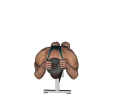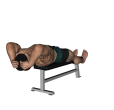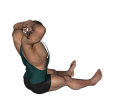 Neck - Iso Front and Back
Neck - Iso Front and Back
Benefits: The primary advantage to a strong neck is that it helps align the rest of your body. Neck exercises are often overlooked by gym goers, so it's important to create awareness around simple neck isometric exercises like these.
Purpose: This exercise tones and strengthens the neck muscles.
Beginner Neck Body Only Push Gym Home
General Info: The neck muscles are responsible for holding your head up. The motion of the neck can be divided into rotation (looking side to side), lateral flexion (ear to shoulder), flexion (chin to sternum) and hyperextension (looking up). The most common neck injury is whiplash. Another common neck problem is limited rotation.
 Neck - Iso Front and Back Alternate
Neck - Iso Front and Back Alternate
Benefits: The primary advantage to a strong neck is that it helps align the rest of your body. Neck exercises are often overlooked by gym goers, so it's important to create awareness around simple neck isometric exercises like these.
Purpose: This exercise tones and strengthens the neck muscles.
Beginner Neck Body Only Push Gym Home
General Info: The neck muscles are responsible for holding your head up. The motion of the neck can be divided into rotation (looking side to side), lateral flexion (ear to shoulder), flexion (chin to sternum) and hyperextension (looking up). The most common neck injury is whiplash. Another common neck problem is limited rotation.
 Neck - Iso Sides
Neck - Iso Sides
Benefits: The primary advantage to a strong neck is that it helps align the rest of your body. Neck exercises are often overlooked by gym goers, so it's important to create awareness around simple neck isometric exercises like these.
Purpose: This exercise tones and strengthens the neck muscles.
Beginner Neck Body Only Push Gym Home
General Info: The neck muscles are responsible for holding your head up. The motion of the neck can be divided into rotation (looking side to side), lateral flexion (ear to shoulder), flexion (chin to sternum) and hyperextension (looking up). The most common neck injury is whiplash. Another common neck problem is limited rotation.
 Neck - Iso Sides Alternate
Neck - Iso Sides Alternate
Benefits: The primary advantage to a strong neck is that it helps align the rest of your body. Neck exercises are often overlooked by gym goers, so it's important to create awareness around simple neck isometric exercises like these.
Purpose: This exercise tones and strengthens the neck muscles.
Beginner Neck Body Only Push Gym Home
General Info: The neck muscles are responsible for holding your head up. The motion of the neck can be divided into rotation (looking side to side), lateral flexion (ear to shoulder), flexion (chin to sternum) and hyperextension (looking up). The most common neck injury is whiplash. Another common neck problem is limited rotation.
 Neck - Lying Face Down Plate
Neck - Lying Face Down Plate
Benefits: The primary advantage to a strong neck is that it helps align the rest of your body. Neck exercises are often overlooked by gym goers, so it's important to create awareness around simple neck isometric exercises like these.
Purpose: This exercise tones and strengthens the neck muscles.
Beginner Neck Plate Flat Bench Push Gym Home
General Info: The neck muscles are responsible for holding your head up. The motion of the neck can be divided into rotation (looking side to side), lateral flexion (ear to shoulder), flexion (chin to sternum) and hyperextension (looking up). The most common neck injury is whiplash. Another common neck problem is limited rotation.
 Neck - Lying Face Up Plate
Neck - Lying Face Up Plate
Benefits: The primary advantage to a strong neck is that it helps align the rest of your body. Neck exercises are often overlooked by gym goers, so it's important to create awareness around simple neck isometric exercises like these.
Purpose: This exercise tones and strengthens the neck muscles.
Beginner Neck Plate Flat Bench Push Gym Home
General Info: The neck muscles are responsible for holding your head up. The motion of the neck can be divided into rotation (looking side to side), lateral flexion (ear to shoulder), flexion (chin to sternum) and hyperextension (looking up). The most common neck injury is whiplash. Another common neck problem is limited rotation.
 Stretch - Chin To Chest
Stretch - Chin To Chest
Benefits: The primary advantage to a strong neck is that it helps align the rest of your body. Neck exercises are often overlooked by gym goers, so it's important to create awareness around simple neck isometric exercises like these.
Purpose: This exercise tones and strengthens the neck muscles.
Beginner Neck Body Only Push Gym Home
General Info: The neck muscles are responsible for holding your head up. The motion of the neck can be divided into rotation (looking side to side), lateral flexion (ear to shoulder), flexion (chin to sternum) and hyperextension (looking up). The most common neck injury is whiplash. Another common neck problem is limited rotation.
 Stretch - Side Neck
Stretch - Side Neck
Benefits: The primary advantage to a strong neck is that it helps align the rest of your body. Neck exercises are often overlooked by gym goers, so it's important to create awareness around simple neck isometric exercises like these.
Purpose: This exercise tones and strengthens the neck muscles.
Beginner Neck Stretching Body Only Gym Home
General Info: The neck muscles are responsible for holding your head up. The motion of the neck can be divided into rotation (looking side to side), lateral flexion (ear to shoulder), flexion (chin to sternum) and hyperextension (looking up). The most common neck injury is whiplash. Another common neck problem is limited rotation.
Could not find your favorite exercise in the list? Please start a discussion and post the name and the list of steps. We will try to add it as soon as we can.